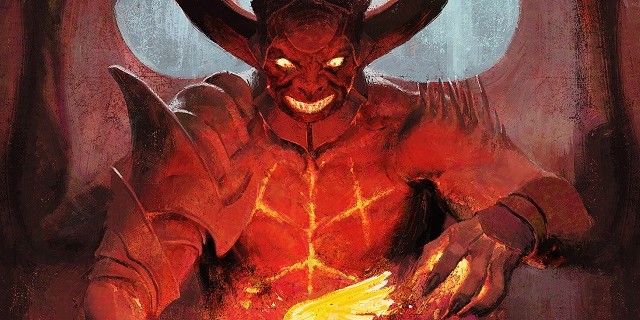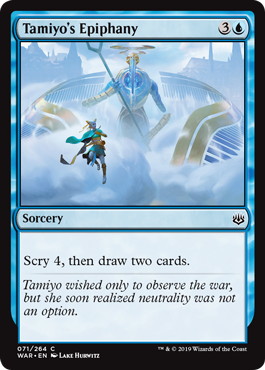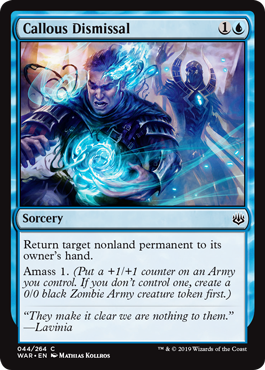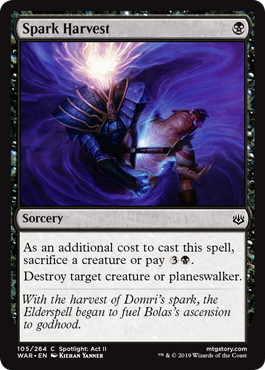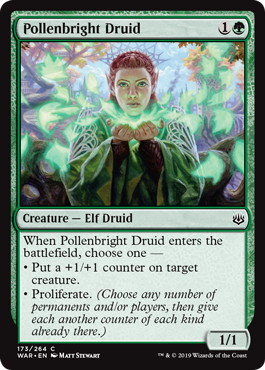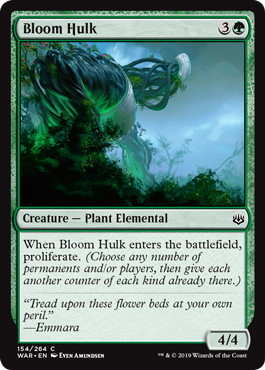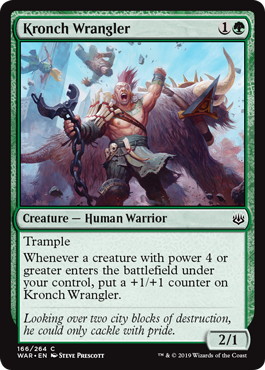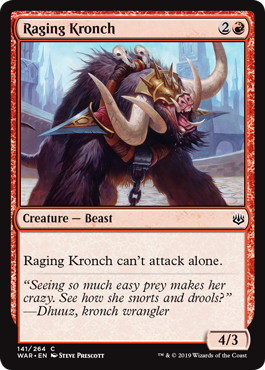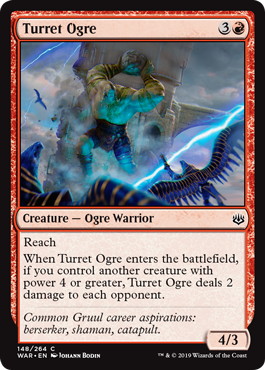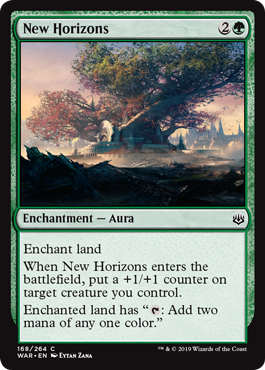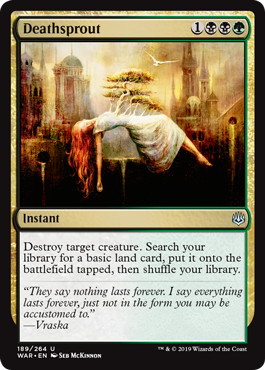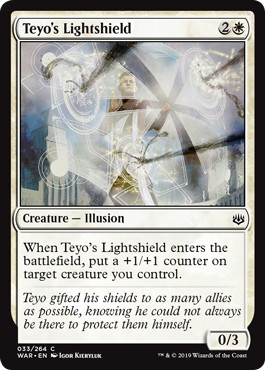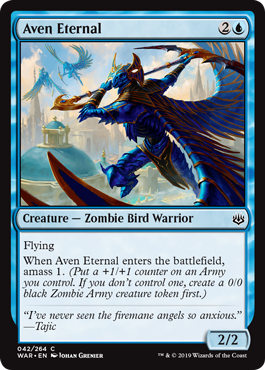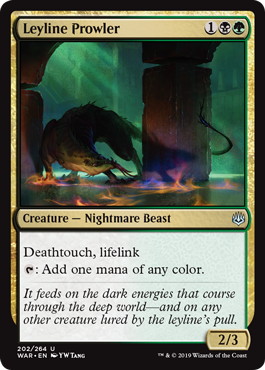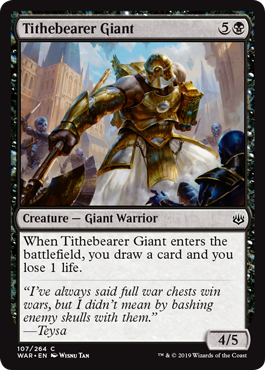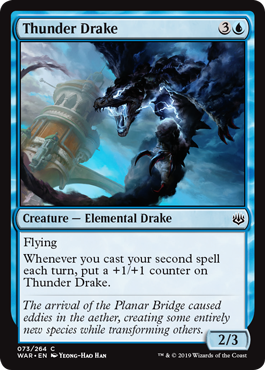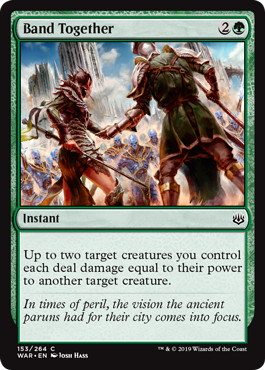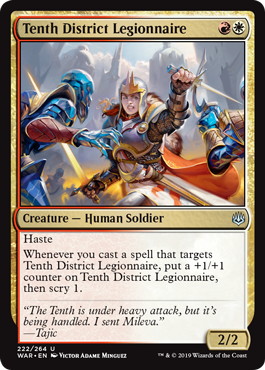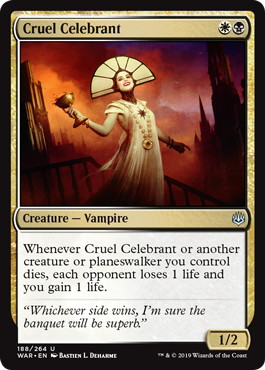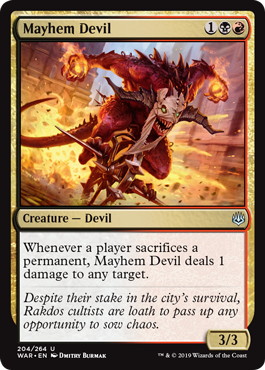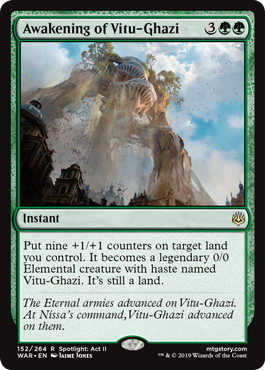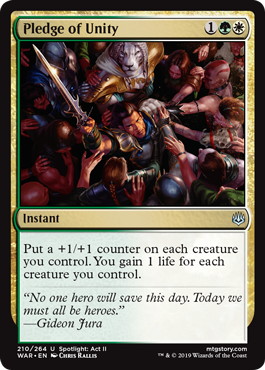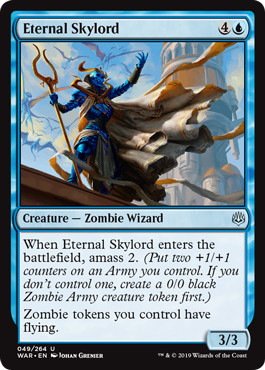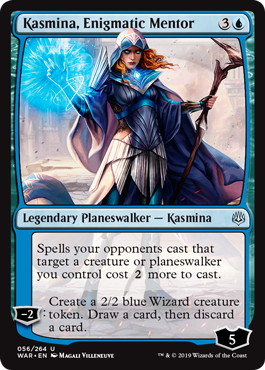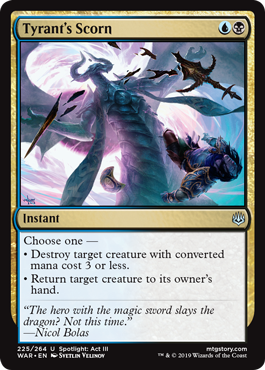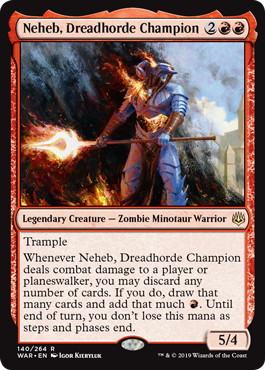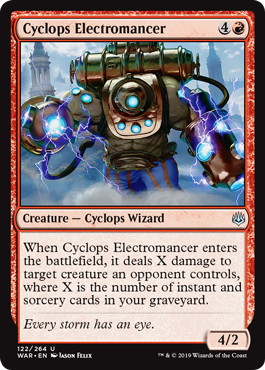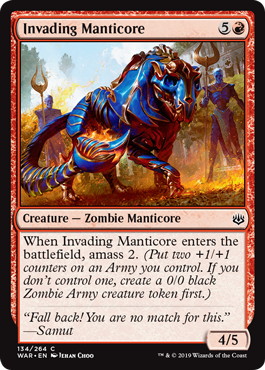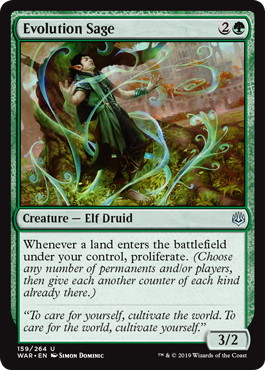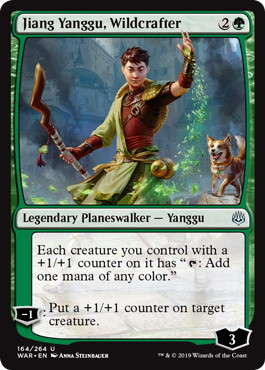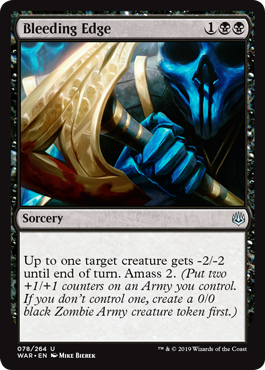Introduction
War of the Spark is now available for everybody, both IRL and on the online platforms. For most of the people this will be the first opportunity to interact with the cards. For me, I was lucky enough to spend the week before Mythic Championship II in Valencia testing with 3 member of the MPL – Javier Dominguez, Andrea Mengucci and Marcio Carvalho. Joining us were also the MOCS players Bernardo Santos, Jose Cabezas, Bernas Torres and Joao Andrade.
This made us one of the best testing groups for War of the Spark Limited and despite my 2-4 record at the MCII I think I have a thing or two to say about the format that will put you ahead of the competition.
Archetypes
Let me start by giving you a small overview of what the archetypes are trying to do, so you can have an idea of what your main goal should be when committing to one of those.
Blue-Red
Usually control with a spell matter subtheme. It has card advantage in cards like 《Tamiyo’s Epiphany》, but it also has the capacity of out tempoing the more slower decks with the spell matter creatures like 《Spellgorger Weird》, 《Burning Prophet》 and 《Sky Theater Strix》. Cards like 《Relentless Advance》 and 《Callous Dismissal》 will help you to have a high number of spells while providing you creatures to maintain board presence. 《Invade the City》 is a super trap, don’t pick it or play it.
Blue-Black
This works as an Old School control deck, where you try to deal with your opponent’s early treats and then 2 for 1 them as much as possible in order to snowball the game out of your their control. Try to not build a huge Zombie Army that your opponent can deal with all at once, instead make them deal with chunks of 3/3’s and 4/4’s in order to dry them out of resources.
Green-White
This is the archetype that abuses more of the synergy between the +1/+1 Counters and the Proliferate. Usually aggro, with lots of early drops that evolves well into the late stages of the game due the Proliferate theme.
Green-Red
The Ferocious theme is key here. Having 4 power creatures enable some important bonus that will add up during the game. The synergies in this archetype are not as evident as in Green-White, Blue-Green or Blue-Red, but it has very good Magic Draft fundamentals. Well sized creatures for its costs, efficient removal and some decent amount of solid combat tricks.
3 or 4 Color Control
Joao Andrade had plenty of success with this archetype during testing. It usually has a BG or UB core, but splashing 1 or 2 colors was very easy, especially if you had access to Green with 《New Horizons》 and 《Deathsprout》. You can get 《Mana Geode》 and 《Guild Globe》 quite late that will help both smooth your draws and fix your mana when you are not in Green. Make sure you have your own 《Tamiyo’s Epiphany》 effects and ways to deal with your opponent’s. You don’t want to feel like you lost the game every time they cast theirs.
Blue-White
This color combination is another classic of MTG draft. You try to stall the ground with some walls, while pushing damage with some flyers. No big synergies between the cards, but some nice Limited fundamentals.
Green-Black
The problem with Green-Black is the lack of ways to compensate the Blue card advantage. Both Black and Green are solid and somehow deep colors, so it took us a while to realize what was wrong with this color combination. It all clicked when we start adding Blue to the mix. I recommend you to always leave that door open, as straight Green-Black felt really underwhelming, unless you pick enough 《Toll of the Invasion》 and 《Tithebearer Giant》s to fight the opponents playing 《Island》s.
Blue-Green
The Counters/Proliferate synergies here were great, but in reality, the decks took too much time to have the ball rolling against the aggro decks while were not fast enough to put pressure on the control decks before get overran by their card advantage. The lack of removal in these colors makes it that 《Band Together》 is absolutely essential when you are drafting this archtype.
White-Red
This archetype can look very good on paper. An aggressive deck with Heroic Subtheme looks very powerful! The issue here is that both Red and White Are not very deep and the best commons are cards that the other Archetypes will also be taking high, no matter what their plan is, such as 《Jaya’s Greeting》, 《Chandra’s Pyrohelix》, 《Wanderer’s Strike》 and 《Law-Rune Enforcer》.
You will be depending too much on the multicolored uncommon and rare cards, and while sometimes it results in you having the sickest deck of the pod, most of the times makes you end up with an underpowered pile of creatures and mediocre combat tricks.
White-Black and Black-Red
These are the color combinations we had the least success with. They both have the sacrifice subtheme, but we never could make anything really work well. Again, this had the problem that it tried to go late and then did not have weapons to deal with the Blue mages.
Pick Order
Now on to the card evaluation! I will go through the best cards of each color, so you can have an idea of which direction you should be taking in the beginning. Keep in mind that this is just a guide and each decision can be different depending on the context. There are many good cards that are not in this list, so don’t think that because it is not here it is unplayable. These are just the more key cards that can help you going into the right direction. Some of the cards have the same rank, this means that we have them on the same level, without any meaningful tie-break. I tried to leave you a visual tier for when the gap between 2 cards was considerable.
Also, I’ve added the multicolored cards to each color, because knowing when to jump for the second color was always one of my personal challenges (for example, you had 1st pick 《Awakening of Vitu-Ghazi》 and have the decision of 《Pledge of Unity》 and 《Band Together》 for second pick).
GOD TIER
Let’s start with the easy ones. We called these cards the god level rares, since all the 5 gods were included. You will be picking those over any common or uncommon so you don’t really need to know which one is better. (It’s 《God-Eternal Oketra》, though 😏)
Rank
P1P1 you should always pick any of those, but P2P1 things can get tricky. Most of these cards have power level to make you change colors, but I would say that the power level in this format is so high that you might be better staying on track and get rewarded with good commons and uncommons coming from your neighbors.
We were successful with Sultai based control decks and we found it easy to splash the 3rd and the 4th color, so take that into consideration when opening one of these. The mana fixing is not at it’s best in this format, but the format is slow enough that many decks will give you enough time to go over the top with that strategy.
Blue
Rank
We considered Blue the best color by a fair margin. Not only we felt it was the most deep in terms of commons and uncommons, but we also felt like the best archetypes were Blue-Red and Blue-Black.
We ranked 《Eternal Skylord》 and 《Kasmina, Enigmatic Mentor》 as the best non-god level cards. 《Merfolk Skydiver》 would have been a strong contender if we didn’t feel like Blue-Green was not in a good position for this format. It wasn’t very aggro like Green-White or Green-Red and its midrange components were easily trumped by the strong control decks.
《Aven Eternal》 and 《Tamiyo’s Epiphany》 were considered as the best commons. It is still very difficult for us to understand which of the 2 is better, but ultimately, we felt like the deck can support any number of Avens and the 《Tamiyo’s Epiphany》 caps at 3, with the 3rd being already on the high end.
The Blue-Black cards were good, but somehow replaceable (《Tyrant’s Scorn》 for 《Callous Dismissal》 and 《Gleaming Overseer》 for 《Aven Eternal》, for example), so not worth to commit to Blue-Black right away.
Lastly, I want to refer how much 《Spellkeeper Weird》 constantly overperformed for us, by being a solid blocker that will provide you board state in the beginning and trade for some extra 《Tamiyo’s Epiphany》 when the game goes long.
Red
Rank
Red should be considered as a support color, as it is not very deep. 《Jaya’s Greeting》 has the power level to be considered the best common in the set, but the fact that the rest relies so much on the uncommons made us opt for the Blue cards when we had to decide early in the draft.
The efficiency of the 2 mana 3 damage is so good that we would pick it over the most powerful cards like 《Neheb, Dreadhorde Champion》 or 《Cyclops Electromancer》. Both the Cyclops and the Blue-Red cards should be picked higher if you know that you are already Blue-Red, but the fact that Red-Green is also a very viable strategy should make you be more conservative before jumping into the spells matter theme.
《Invading Manticore》 deserves a reference here. It seamed overwhelming at first, but the fact that it will provide you 6/7 power split in 2 bodies for 6 mana really accomplishes more than it initially looked. The ability of providing 2 bodies helps you stabilize efficiently on Blue-Red. On Red-Green it provides you enablers for both Ferocity and Proliferate while not having to put all the 6 mana worth of eggs in the same basket.
Green
Rank
《Pledge of Unity》 and 《Evolution Sage》 are above all the others by a fair margin. If you are early in the draft you should go for the Mono-Green card, but if you are already Green White, then you should go for the Pledge. Giving all your creatures +1/+1 right away can put you immediately ahead, and once you have one counter on each creature, every Proliferate is an extra 《Glorious Anthem》 and it runs out of control very quickly. Obviously, the dream is to have both.
《Band Together》 and 《Bloom Hulk》 are by far the best Green commons and it is always difficult to know which one to pick. I would go for the removal early in the draft, but then pick according to the needs.
Planeswalkers are much better in Green, because the Proliferate is already a mechanic you want to be cashing in.
The Green-Black Cards came down in the list because it is not a color combination we would like to jump right away. With that said, the power level of those cards are very high and if you feel like Green-Black is the place to be, do not hesitate in picking those higher than some of the Mono-Green cards on the list.
Black
Rank
《Bleeding Edge》 comes on the top of the list for its capacity to 2 for 1 your opponent on turn 3 without needing any kind of set-up. 《Ob Nixilis’s Cruelty》 comes as a super-efficient removal that makes the top of the list of every single draft format.
《Kaya, Bane of the Dead》, although very good is in a color combination that we found out to be almost unplayable. Costing 3 specific makes it harder to be a slam dunk, and at 6 mana there are lots of other powerful things you can be doing.
Again, the Blue-Black cards come down, because are easily replaceable and the Green-Black because the combination is not the best.
I would like to give a shout out to 《Toll of the Invasion》, because for a card that started as pretty much not maindeckable started to go higher and higher on our pick order. There are many good cards in this format that you always end up getting something worth. The small improvement to your board state is usually relevant enough that you don’t fall that much behind on the board the turn you cast it.
White
Rank
We considered White as the weakest color. Ultimately, if you are White you want to be Green-White. That is the reason why the Green-White cards or the cards that work better in that archetype are so high on the list, compared to more powerful cards such as Feather or Sorin.
《Prison Realm》 is a very strong unconditional removal, that Scry for a small cost of only 3 mana, so it goes side by side with the pledge.
The 3 top White commons are very good, but there is not much else after that. It is funny that what we though was an improved Pegasus was actually a nerf, as the 2 toughness is much easier to kill and much more difficult to attack without efficiently. Still pretty good, especially if you start with the pump and Proliferate shenanigans.
Conclusion
I hope this gives you a good jump start in the format and if you have any questions, please let me know in the comments section down below. I hope this helps you to develop your skills quicker and that you can learn a lot from it. More than knowing the exact rank of the cards, try to understand the reason behind it, and always try to find a reason for having it in your deck.
I would like to send big props to our testing group for all the things I learned from them, while having a great time.
Gonçalo @u_mad_bro_MTGO on Twitter


